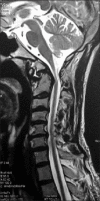Dystopic Os Odontoideum Causing Cervical Myelopathy: A Rare Case Report and Review of Literature
- PMID: 32181211
- PMCID: PMC7057904
- DOI: 10.4103/ajns.AJNS_35_19
Dystopic Os Odontoideum Causing Cervical Myelopathy: A Rare Case Report and Review of Literature
Abstract
Os odontoideum (OO) was first described by Giacomini in 1886 as separation of the odontoid process from the body of the axis. Instability can consequently occurs at this level due to the failure of the transverse atlantal ligament (TAL) and this atlantoaxial instability can be a cause of progressive neurological deficits. It is considered a rare anomaly of the odontoid process. It is a disease with controversial etiology, debatable incidence, and only a partly known natural history owing to the paucity of the literature on this topic. There are insufficient demographic data about the occurrence of the disease, and most of the management is dictated by the isolated case reports and few studies which have been carried out at handful of institutes. OO is classified into two types by Fielding et al. based on the anatomic location: orthotopic and dystopic. Orthotopic OO consists of an ossicle that moves with the anterior arch of the atlas, whereas the dystopic type presents as an ossicle near the basion or one that is fused with the clivus. In one magnetic resonance imaging (MRI) study of odontoid morphology, a 0.7% (1 case of 133 patients) incidence was reported. The spectrum of the clinical presentation varies from completely asymptomatic individuals to patients presenting with features of cervical myelopathy. Here, we present a case of 35-year-old-male with dystopic OO who presented to us with features of gradually progressing cervical myelopathy without any obvious history of neck trauma. On investigations, he was found to have atlantoaxial instability with wide atlanto-dens interval. He was treated with the posterior C1-C2 stabilization and reduction of atlantoaxial instability.
Keywords: Cervical; Os odontoideum; dystopic; myelopathy.
Copyright: © 2020 Asian Journal of Neurosurgery.
Conflict of interest statement
There are no conflicts of interest.
Figures







Similar articles
-
Os Odontoideum.2024 Feb 27. In: StatPearls [Internet]. Treasure Island (FL): StatPearls Publishing; 2025 Jan–. 2024 Feb 27. In: StatPearls [Internet]. Treasure Island (FL): StatPearls Publishing; 2025 Jan–. PMID: 31194437 Free Books & Documents.
-
Reduction of atlantoaxial dislocation prevented by pathological position of the transverse ligament in fixed, irreducible os odontoideum: operative illustrations and radiographic correlates in 41 patients.J Neurosurg Spine. 2017 Jul;27(1):20-28. doi: 10.3171/2016.11.SPINE16733. Epub 2017 Apr 7. J Neurosurg Spine. 2017. PMID: 28387614
-
Cervical myelopathy involving os odontoideum with retro-odontoid cyst and atlanto-axial instability: A case report.Radiol Case Rep. 2022 Apr 8;17(6):1982-1985. doi: 10.1016/j.radcr.2022.03.046. eCollection 2022 Jun. Radiol Case Rep. 2022. PMID: 35432685 Free PMC article.
-
Diagnosis, Classifications, and Treatment of Os Odontoideum: WFNS Spine Committee Recommendations.Spine (Phila Pa 1976). 2025 Jun 1;50(11):743-750. doi: 10.1097/BRS.0000000000005277. Epub 2025 Jan 29. Spine (Phila Pa 1976). 2025. PMID: 39876600
-
Os odontoideum and craniovertebral junction instability secondary to dystonia: case series and review of the literature.Eur Spine J. 2024 Mar;33(3):1164-1170. doi: 10.1007/s00586-023-08044-1. Epub 2023 Nov 23. Eur Spine J. 2024. PMID: 37994987 Review.
Cited by
-
Dystopic Os Odontoideum With Chronic Posterior Atlantoaxial Subluxation: A Case Report.Cureus. 2024 Oct 31;16(10):e72749. doi: 10.7759/cureus.72749. eCollection 2024 Oct. Cureus. 2024. PMID: 39483590 Free PMC article.
-
Os odontoideum: A comprehensive review.J Craniovertebr Junction Spine. 2022 Jul-Sep;13(3):256-264. doi: 10.4103/jcvjs.jcvjs_71_22. Epub 2022 Sep 14. J Craniovertebr Junction Spine. 2022. PMID: 36263339 Free PMC article. Review.
-
Degenerative Cervical Myelopathy: History, Physical Examination, and Diagnosis.J Clin Med. 2024 Nov 25;13(23):7139. doi: 10.3390/jcm13237139. J Clin Med. 2024. PMID: 39685599 Free PMC article. Review.
References
-
- Giacomini C. Sull' esistenza dell' “os odontoideum” nell' uomo. Gior Accad Med Torino. 1886;49:24–8.
-
- Fielding JW, Hensinger RN, Hawkins RJ. Os Odontoideum. J Bone Joint Surg Am. 1980;62:376–83. - PubMed
-
- Perdikakis E, Skoulikaris N. The odontoid process: Various configuration types in MR examinations. Eur Spine J. 2014;23:1077–83. - PubMed
-
- Tejada Meza H, Modrego Pardo P, Gazulla Abio J. Cervical myelopathy as the initial manifestation of os odontoideum. Neurologia. 2016;31:278–9. - PubMed
-
- Zhang Z, Wang H, Liu C. Acute traumatic cervical cord injury in pediatric patients with os odontoideum: A series of 6 patients. World Neurosurg. 2015;83:1180e1–6. - PubMed
Publication types
LinkOut - more resources
Full Text Sources
Miscellaneous

